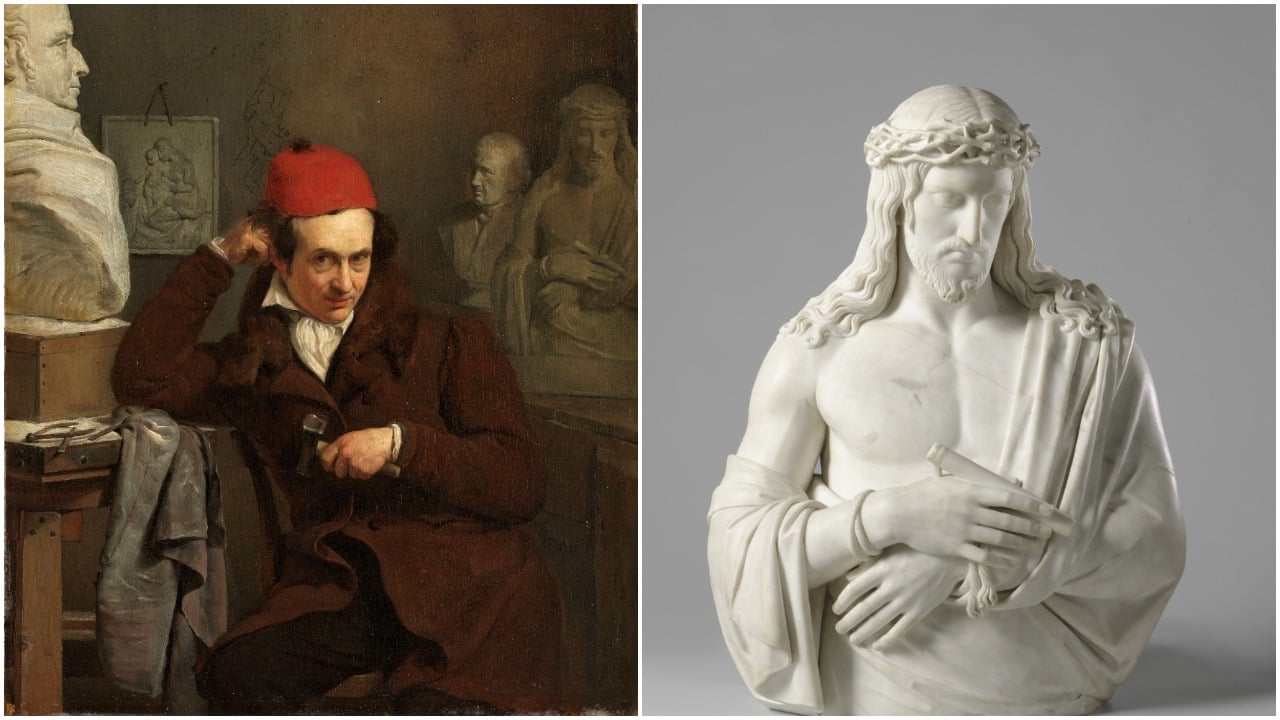Eighteen young authors have brought nineteenth-century artefacts from the Rijksmuseum to life. They have taken inspiration from the question: what do you see when you look at these objects with an eye for invisible labour? Marte Hoogenboom wrote a dialogue in response to Charles van Beveren’s 1830 Portrait of Louis Royer and Louis Royer’s 1826 Ecce Homo. ‘Human hands are like supple clay that never dries.’
 Portrait of Louis Royer, Charles van Beveren, c. 1830 and Ecce Homo, Louis Royer, c. 1826.
Portrait of Louis Royer, Charles van Beveren, c. 1830 and Ecce Homo, Louis Royer, c. 1826.© Rijksmuseum Collection, Amsterdam
Behold, yourself
To be recited on a new-born’s first breath.
(Breath.)
Who’s there? Where are we? Who are you?
I am that –
I’m wet. Why am I wet?
I am –
I’m bleeding.
Hush, we’re not alone. What if they hear us?
I’m bleeding!
It will dry. Just look at me. My veins calcified millions of years ago.
Who are they? Who might hear us?
Him I know. The dirty bastard, he did this to me. But the other one? He’s rubbing something on your cheek.
Can you see what it is?
It’s grey and wet. Oils and pigment.
Thank God, not blood.
I think it’s – you’re supposed to represent me. Now he’s making a start on the hands of my executioner. Those small, delicate hands. Human hands are like supple clay that never dries, never stops. Without his tools, the executioner is weaker than a young mountain stream. Certainly more impatient.
Can they not hear us?
I think they’re turning a deaf ear to us.
‘Creators’, I hear they used to call themselves. It still resonates in the wood below my skin.
Hah! Human hands are incapable of creating, only violently eradicating. They arm themselves with chisels and hammers to be either tooth or claw. In a single afternoon, they chip millions of years off my body. That’s what they call ‘immortalisation’.
I would also want to believe in eternity if my body were made of never-drying clay. No fear of sunlight, humidity, drought.
Insane. Look what he did to me. Had me robbed from my own abdominal wall, with pickaxes and saws and froes. Shipped across the sea under which I slept for billions of years, before I rose above her. Hundreds of hands brought me to this one pair. And then? My nipple could have been a robin’s beak; my crown a playing child’s garland.
I hear the echoes of a battle being fought out over their heads. A feud – who’s best at capturing nature?
What a ludicrous question; you cannot capture nature. Only chase it away. For days on end, he watched me like a predator, supposedly to see what’s under my skin. He hollowed me out then, from the outside in. And then? Kiss me like Pygmalion? Leave me alone. Let them reconcile. I’m a glorified mirror.
And I’m liquid marble.
Don’t get carried away now. You were made in my image.
And you in that of your maker. You’re a three-dimensional self-portrait of a man who can only see himself. Lily-white, holy.
People do whatever it takes to see themselves. But they only see who they want to see – who they want to be.
What’s happening now?
All around them, photography is being perfected. Another force of nature: fleeting, inflammable elements burning their ‘eternity’ onto an artificial retina.
And now?
They’re looking at each other. At their work. At themselves. Who is the eye in this whirlwind of gazes?
And now?
They’re looking at each other.
They’re looking at (breath) themselves.












